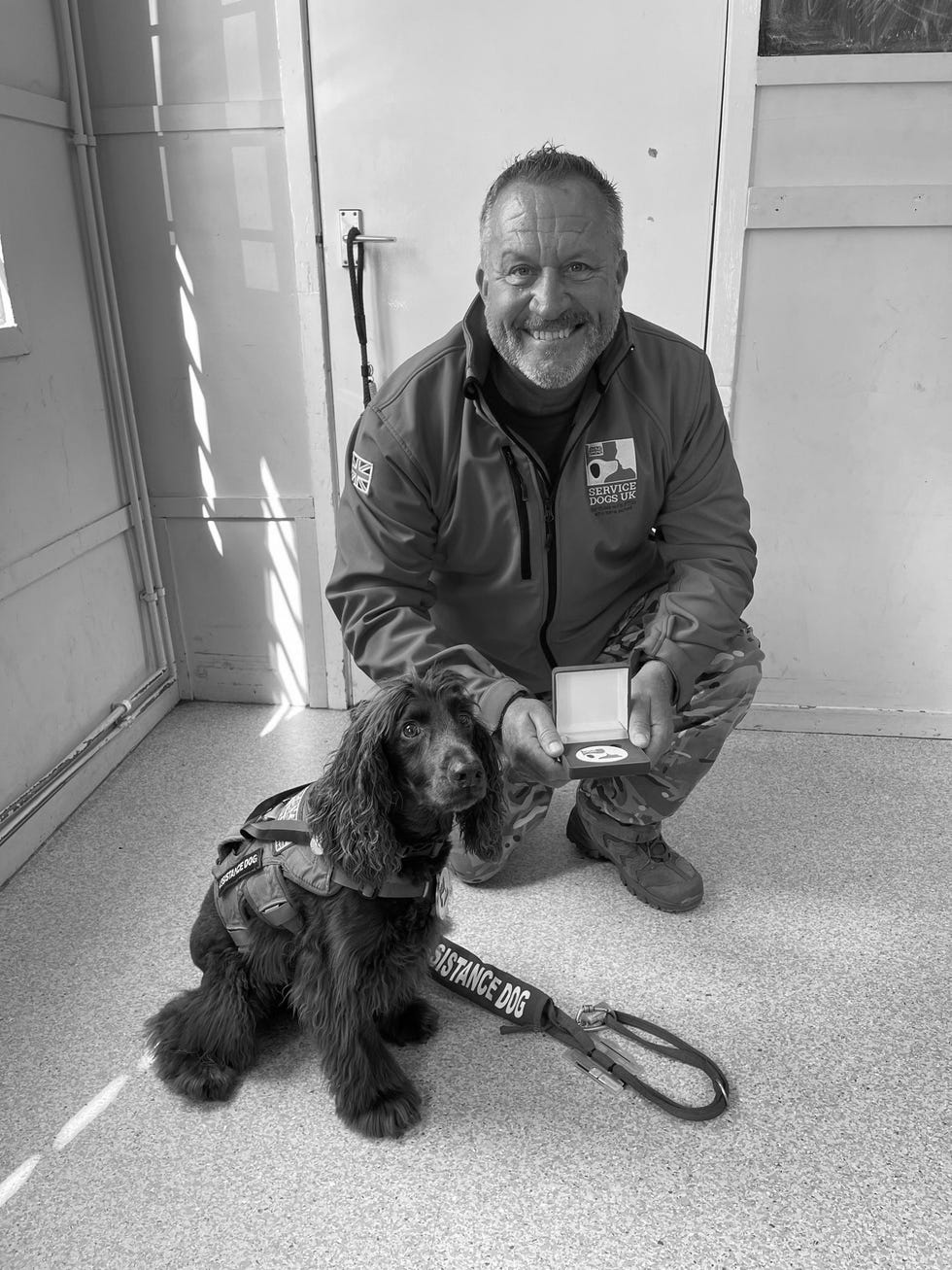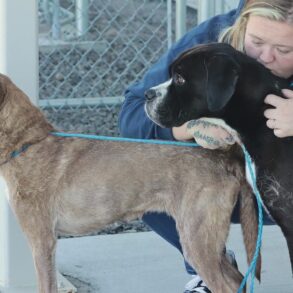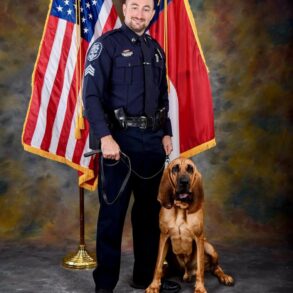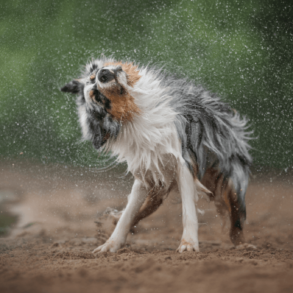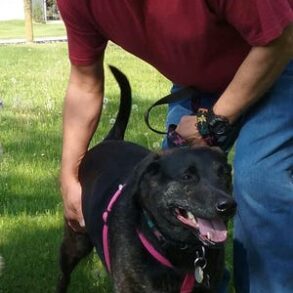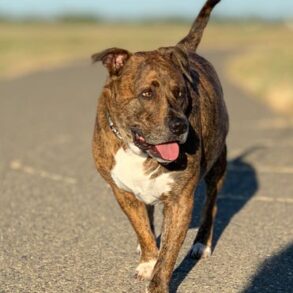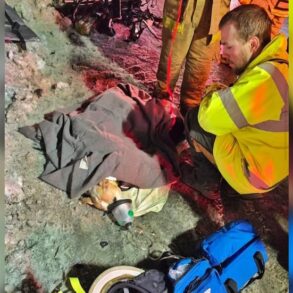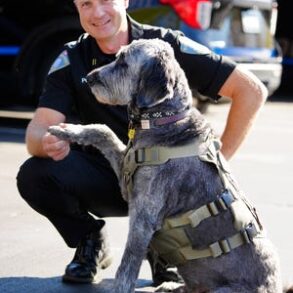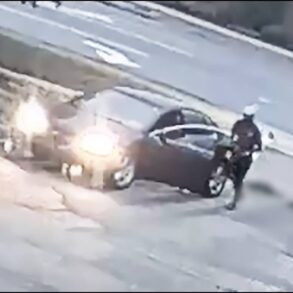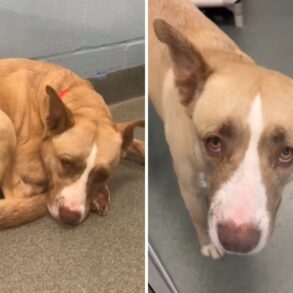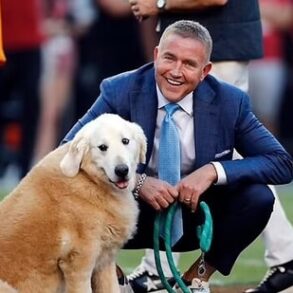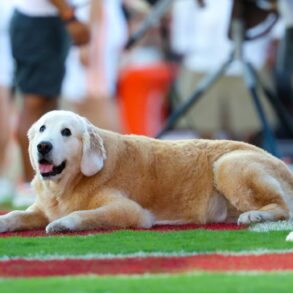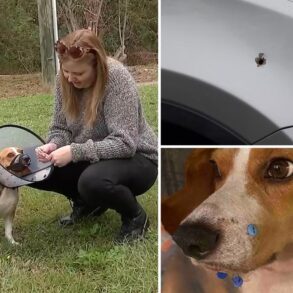In 2008, when I was deployed with the British army, I suffered quite bad spinal injuries. I can’t go into detail, but I was in hospital for a long time, then spent two years in a wheelchair. I was told I would never walk again.
Then in 2011, I was medically discharged from the army, and went into a quite bad depression. At least, that’s what I thought it was. A consultant told me, ‘I think you’ve got PTSD.’ I said that I didn’t think so, and left it at that. There’s a stigma – you don’t want to admit that you’re losing control.
Even as I was pushing help away, I knew that I was getting worse. My relationship was failing, the kids weren’t ringing me up anymore, and I was becoming quite an angry person, which just isn’t me.
I was still in quite a bad way, and not really mobile, when my family bought me a little cocker spaniel puppy. They thought that she’d help get me out of bed in the morning, and she did. But when she was six, we found out she had bone cancer, and we had to put her down. I was devastated.
In 2015, after I’d finally been diagnosed with PTSD, I met another veteran who had an assistance dog. I thought, ‘I’ve got to do this.’ I applied online to the Service Dogs UK charity.
Then I learned that a friend was being deployed for a few years, and needed to find a new home for his little cocker spaniel, Jerry. After meeting him a couple of times, I brought Jerry home with me.
Service Dogs UK typically get their dogs from Dogs Trust, but they said if Jerry could pass some tests, they’d take him on for training. We met at a cafe in Petersfield town centre. Bear in mind that I hadn’t been out much, because of my PTSD and physical disabilities – this was a big deal.
Garry Botterill, the founder of Service Dogs UK, took Jerry through a few exercises to see if he had the right temperament for training. It’s no good having a dog that’s going to run at the slightest noise; they’ve got to be calm. Garry walked Jerry past a shopping trolley, then a bus. He didn’t flinch.
When Jerry passed all the tests, Garry said we could join the Service Dogs UK programme. Back then, I was only the second person to join; now I’m a mentor with the organisation.
At Service Dogs UK, we teach veterans how to train a dog, so that they’ve got that toolbox. It’s quite funny watching them get paired up – they choose each other. After a couple of weeks, it’s like they’ve been together a lifetime.
The course takes about nine months. Many of the veterans have never had a dog before, so it can be daunting. I get what they’re going through, so I can help them when they’re struggling and give tips for how to connect with their dog.
Jerry knows every command perfectly. He’ll wait for me to go through a doorway, or go on ahead. At restaurants, he settles underneath the table – you wouldn’t even know there was a dog there.
We do everything together; it’s like he knows what I’m thinking. Most people with PTSD have a little tic: they might play with a ring, or put their head in their hands. If Jerry sees me doing that, he’ll try to distract me. If I have a nightmare, Jerry will nudge me to wake me up, then he’ll turn on the light.
He’s also trained to fetch my medication: when he hears a certain alarm go off on my phone, he’ll go flying down the stairs, pull open the cupboard door, get the morphine and bring it back to me.
It’s all fun, for Jerry – but when the jacket comes off, he gets to be a dog, barking and chasing a ball. He especially likes to be brushed. He’s 11 now, which I try to be mindful of: I wouldn’t take him to a day-long rock concert, for example. It’s about showing your dog respect.
Veterans often struggle with thinking that progress is linear, from A to B. I think animals can help you to slow down, and focus on what’s possible now. They also change the dynamic of your home. You’ll sit down to dinner or watch TV, and they’ll curl up on your lap. Jerry likes to just sit there and stare at me.
I still have my down days, but they’re not as bad as they were. When I feel one coming on, I’ll take Jerry out into the countryside and we’ll have a good old chat. People will think I’m talking to myself – but he gets it.
That’s the thing about service dogs: it’s a relationship, you’re there for each other. To see how far some of our veterans come in a month is awe-inspiring.
The Expert View
Donna Butler is an integrative psychotherapist specialising in trauma, and a trustee of Service Dogs UK
What is post-traumatic stress disorder (PTSD)?
PTSD is a mental health condition caused by experiencing a very stressful, frightening or distressing event. According to the NHS, one in every three people who have experienced trauma are affected by PTSD, and it can develop weeks, months and even years after the event.
People with PTSD often relive the trauma in flashbacks and nightmares. They might have difficulties sleeping, concentrating and regulating their mood or nervous system.
How can a dog help?
An assistance dog can help to keep a person grounded when they are triggered or distressed. ‘Service dogs are really good at interrupting certain behaviours, or psychological disturbances,’ says Butler. ‘They get trained to come between the arms or legs of a person when they’re experiencing a flashback.’
Assistance dogs can support people with PTSD through situations they might find difficult, such as being around crowds. ‘The neurophysiological effects of being around a dog aren’t fully understood, but several studies have reported the positive effect on blood pressure, heart rate and decreased cortisol production.’
Developing that bond with their canine companion can also help people with PTSD to recover their sense of purpose, and lend structure to their days.
This post was originally published on this site be sure to check out more of their content.




